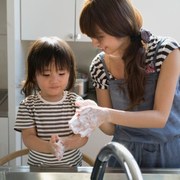Impetigo is a highly contagious bacterial infection. It affects the surface layers of the skin, and can cause blisters, itching and scaling. The causes of impetigo are two types of bacteria.
The most common is Staphylococcus aureus (staph), and the other is Streptococcus pyogenes (strep). While it is not usually serious, precautions must be taken to avoid spread to others.
Newborn babies, in particular, are highly sensitive and can be affected adversely by impetigo. It can be very uncomfortable to experience. Washing all affected areas, hands, bed linens, clothing, towels and anything else that has come into contact with an infected individual is a great way to assist the process of helping to avoid the spread.
Treatments for impetigo include antibiotic creams, and in some cases, it will clear up on its own. However, be careful because impetigo is contagious for a full 48 hours.
Once sores have healed and dried up, it can no longer be spread to others.
Most of the time impetigo can get better on its own. If there are complications, it can usually spread to the lymph nodes (called lymphadenitis) or to a deeper layer of the skin.
The two types of impetigo are:
• non-bullous impetigo - which is more contagious than bullous impetigo and causes sores that quickly rupture (burst) to leave a yellow-brown crust
• bullous impetigo - which causes large, painless, fluid-filled blisters
Impetigo can also be classed as:
• primary - where bacteria enters skin through a cut or wound. This occurs in skin which is, aside from that wound health.
• secondary – this is when the impetigo infection is the result of atopic eczema or another skin condition or underlying cause.
Non-bullous impetigo is the most common type of impetigo. It accounts for more than 70 percent of cases.
The people most affected by impetigo are children. Mostly this is a result of children being exposed to so many more environments where there is a possibility to contract the disease, such as daycare centers and school environments.
Adults are most often affected by impetigo when living in very close quarters, such as army barracks.
Symptoms of impetigo include:
• fluid-filled blisters
• Red sores that rupture quickly, ooze for a few days and then form a brown or yellowish crust
• Itching
• Painful fluid- or pus-filled sores which can become deep ulcers in the more serious form
Most children can return to school fairly quickly after being treated for impetigo. As soon as a doctor or pediatrician deems the contagious period to be over, and as long as the discomfort is not unbearable, daily functioning may resume.
Sources:
Impetigo Causes By Mayo Clinic Staff. Retrieved from the internet on October 29, 2011.
http://www.mayoclinic.com/health/impetigo/DS00464/DSECTION=causes
CNNHealth. Impetigo. Retrieved from the internet on October 29, 2011
http://www.cnn.com/HEALTH/library/impetigo/DS00464.html
NHS Choices. Impetigo. Retrieved from the internet on October 29, 2011
http://www.nhs.uk/conditions/Impetigo/Pages/Introduction.aspx
Aimee Boyle is a regular contributor to Empowher
Reviewed November 3, 2011
by Michele Blacksberg RN
Edited by Jody Smith




Add a CommentComments
There are no comments yet. Be the first one and get the conversation started!